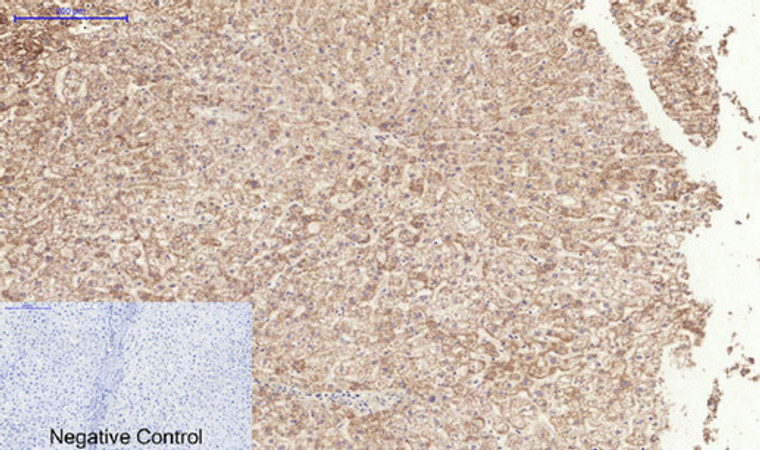| Host: |
Rabbit |
| Applications: |
WB/IHC/IF/ELISA |
| Reactivity: |
Human/Mouse/Rat |
| Note: |
STRICTLY FOR FURTHER SCIENTIFIC RESEARCH USE ONLY (RUO). MUST NOT TO BE USED IN DIAGNOSTIC OR THERAPEUTIC APPLICATIONS. |
| Short Description: |
Rabbit polyclonal antibody anti-Phospho-TGF-beta receptor type-1-Ser165 (131-180 aa) is suitable for use in Western Blot, Immunohistochemistry, Immunofluorescence and ELISA research applications. |
| Clonality: |
Polyclonal |
| Conjugation: |
Unconjugated |
| Isotype: |
IgG |
| Formulation: |
Liquid in PBS containing 50% Glycerol, 0.5% BSA and 0.02% Sodium Azide. |
| Purification: |
The antibody was affinity-purified from rabbit antiserum by affinity-chromatography using epitope-specific immunogen. |
| Concentration: |
1 mg/mL |
| Dilution Range: |
WB 1:500-2000IF 1:50-300IHC 1:50-300 |
| Storage Instruction: |
Store at-20°C for up to 1 year from the date of receipt, and avoid repeat freeze-thaw cycles. |
| Gene Symbol: |
TGFBR1 |
| Gene ID: |
7046 |
| Uniprot ID: |
TGFR1_HUMAN |
| Immunogen Region: |
131-180 aa |
| Specificity: |
Phospho-TGF Beta RI (S165) Polyclonal Antibody detects endogenous levels of TGF Beta RI protein only when phosphorylated at S165. |
| Immunogen: |
The antiserum was produced against synthesized peptide derived from the human TGF beta Receptor I around the phosphorylation site of Ser165 at the amino acid range 131-180 |
| Post Translational Modifications | Phosphorylated at basal levels in the absence of ligand. Activated upon phosphorylation by TGFBR2, mainly in the GS domain. Phosphorylation in the GS domain abrogates FKBP1A-binding. N-Glycosylated. Ubiquitinated.undergoes ubiquitination catalyzed by several E3 ubiquitin ligases including SMURF1, SMURF2 and NEDD4L2. Results in the proteasomal and/or lysosomal degradation of the receptor thereby negatively regulating its activity. Deubiquitinated by USP15, leading to stabilization of the protein and enhanced TGF-beta signal. Its ubiquitination and proteasome-mediated degradation is negatively regulated by SDCBP. |
| Function | Transmembrane serine/threonine kinase forming with the TGF-beta type II serine/threonine kinase receptor, TGFBR2, the non-promiscuous receptor for the TGF-beta cytokines TGFB1, TGFB2 and TGFB3. Transduces the TGFB1, TGFB2 and TGFB3 signal from the cell surface to the cytoplasm and is thus regulating a plethora of physiological and pathological processes including cell cycle arrest in epithelial and hematopoietic cells, control of mesenchymal cell proliferation and differentiation, wound healing, extracellular matrix production, immunosuppression and carcinogenesis. The formation of the receptor complex composed of 2 TGFBR1 and 2 TGFBR2 molecules symmetrically bound to the cytokine dimer results in the phosphorylation and the activation of TGFBR1 by the constitutively active TGFBR2. Activated TGFBR1 phosphorylates SMAD2 which dissociates from the receptor and interacts with SMAD4. The SMAD2-SMAD4 complex is subsequently translocated to the nucleus where it modulates the transcription of the TGF-beta-regulated genes. This constitutes the canonical SMAD-dependent TGF-beta signaling cascade. Also involved in non-canonical, SMAD-independent TGF-beta signaling pathways. For instance, TGFBR1 induces TRAF6 autoubiquitination which in turn results in MAP3K7 ubiquitination and activation to trigger apoptosis. Also regulates epithelial to mesenchymal transition through a SMAD-independent signaling pathway through PARD6A phosphorylation and activation. |
| Protein Name | Tgf-Beta Receptor Type-1Tgfr-1Activin A Receptor Type Ii-Like Protein Kinase Of 53kdActivin Receptor-Like Kinase 5Alk-5Alk5Serine/Threonine-Protein Kinase Receptor R4Skr4Tgf-Beta Type I ReceptorTransforming Growth Factor-Beta Receptor Type ITgf-Beta Receptor Type ITbetar-I |
| Database Links | Reactome: R-HSA-2173788Reactome: R-HSA-2173789Reactome: R-HSA-2173791Reactome: R-HSA-3304356Reactome: R-HSA-3645790Reactome: R-HSA-3656532Reactome: R-HSA-3656535Reactome: R-HSA-5689603Reactome: R-HSA-5689880 |
| Cellular Localisation | Cell MembraneSingle-Pass Type I Membrane ProteinCell JunctionTight JunctionCell SurfaceMembrane Raft |
| Alternative Antibody Names | Anti-Tgf-Beta Receptor Type-1 antibodyAnti-Tgfr-1 antibodyAnti-Activin A Receptor Type Ii-Like Protein Kinase Of 53kd antibodyAnti-Activin Receptor-Like Kinase 5 antibodyAnti-Alk-5 antibodyAnti-Alk5 antibodyAnti-Serine/Threonine-Protein Kinase Receptor R4 antibodyAnti-Skr4 antibodyAnti-Tgf-Beta Type I Receptor antibodyAnti-Transforming Growth Factor-Beta Receptor Type I antibodyAnti-Tgf-Beta Receptor Type I antibodyAnti-Tbetar-I antibodyAnti-TGFBR1 antibodyAnti-ALK5 antibodyAnti-SKR4 antibody |
Information sourced from Uniprot.org
12 months for antibodies. 6 months for ELISA Kits. Please see website T&Cs for further guidance











